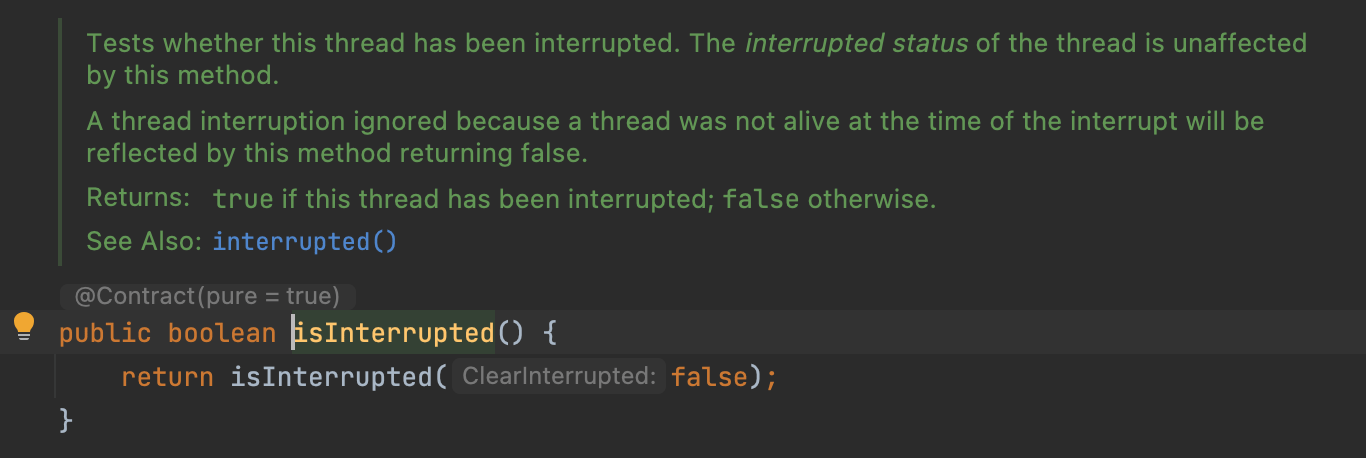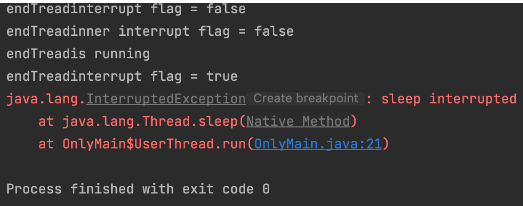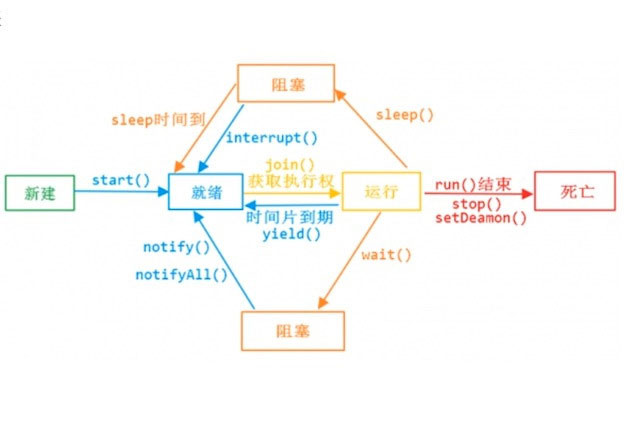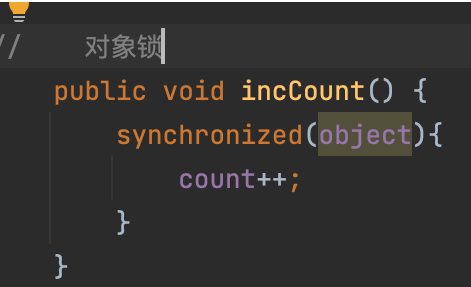Java 多线程
半身风雪 人气:0一、Java 中的线程
一个Java 程序从main() 方法开始执行,然后按照既定的代码逻辑执行,看似没有其他线程参与,但实际上Java
程序天生就是多线程程序,因为执行main() 方法的是一个名称为main 的线程。
public static void main(String[] args) {
// java 虚拟机线程系统的管理接口
ThreadMXBean threadMXBean = ManagementFactory.getThreadMXBean();
// 不需要获取同步的monitor 和synchronizer 信息,仅仅获取线程和线程堆栈信息
ThreadInfo[] threadInfos = threadMXBean.dumpAllThreads(false, false);
// 遍历线程,仅打印线程ID 和线程名称信息
for (ThreadInfo threadInfo : threadInfos) {
System.out.println("线程ID" + threadInfo.getThreadId() + "线程名" + threadInfo.getThreadName());
}
}上面代码输出的结果:

- $\textcolor{red}{Monitor Ctrl-Break}$ 监控 Ctrl-Break 中断信号的
- $\textcolor{red}{Signal Dispatcher}$ 分发处理发送给 JVM 信号的线程
- $\textcolor{red}{ Finalizer }$ 调用对象 finalize 方法的线程
- $\textcolor{red}{Reference Handler}$ 清除 Reference 的线程
- $\textcolor{red}{ main }$ main 线程,用户程序入口
从上面的例子中,我们能发现,在Java中短短的几行代码,就给我们启动了5个线程,当然,不同的版本,启动的线程数量也不一样,由此我们可以得出:**Java
天生就是多线程的**
1、启动
线程的启动方式有两种(源码中的注释是这么写的)参见代码:cn.enjoyedu.ch1.base.NewThread:
- X extends Thread;,然后 X.start
- X implements Runnable;然后交给 Thread 运行
示例代码:(派生自Thread 类,来实现我们的两种线程启动方式)
/**
* 扩展自Thread 类
*/
private static class UserThread extends Thread{
@Override
public void run() {
System.out.println("UserThread.run");
}
}
/**
* 扩展自 Runnable 类
*/
private static class UserRunnable implements Runnable {
@Override
public void run() {
System.out.println("UserRunnable.run");
}
}
public static void main(String[] args) {
UserThread userThread = new UserThread();
userThread.start();
UserRunnable userRunnable = new UserRunnable();
new Thread(userRunnable).start();
}Thread 和 Runnable 的区别:
Thread是Java 里对线程的唯一抽象。Runnable是Java对任务(业务逻辑)的抽象。Thread可以接受任意一个Runnable的实例并执行。
2、中止
线程自然终止:要么是run 执行完成了,要么是抛出了一个未处理的异常导致线程提前结束。stop:暂停、恢复和停止操作对应在线程Thread的API就是suspend()、resume() 和 stop()。但是这些API都是过期的,不再建议使用。不建议使用的主要原因有:以suspend()方法为例,在调用后,线程不会释放已占有的资源(比如锁),而是占有资源进入睡眠状态,这样容易引发死锁问题。同样,stop()方法在终结一个线程时,不会保证线程的资源正常释放,通常是没有给予线程完成资源释放的机会,因此会到导致程序可能工作在不确定的状态下。整因为suspend()、resume() 和 stop()方法带来的副作用,这些方法才会被标注为不建议使用的过期方法中。中断:安全的中止则是其它线程通过调用线程A的interrupt()方法对其进行中止操作,中断代表着其它线程对A线程打了个招呼,“A, 你要中断了”,不代表线程A 会立即停止自己的工作,同样A线程可以不理会这种请求。因为Java 中的线程是协作式的,不是抢占式。线程通过检查自身的中断标志位是否被置为true来进行响应。
private static class UserThread extends Thread{
public UserThread(String name){
super(name);
}
@Override
public void run() {
String threadName = Thread.currentThread().getName();
System.out.println(threadName + "interrupt flag = " + isInterrupted());
while (!isInterrupted()){
// while (!Thread.interrupted()){
// while (true){
System.out.println(threadName+ "is running");
System.out.println(threadName+ "inner interrupt flag = "+ isInterrupted());
}
System.out.println(threadName+ "interrupt flag = " + isInterrupted());
}
}
public static void main(String[] args) {
Thread endTread = new UserThread("endTread");
endTread.start();
try {
Thread.sleep(20);
} catch (InterruptedException e) {
e.printStackTrace();
}
// 中断线程, 其实设置线程的标识位
endTread.interrupt();
}运行上面的代码:

我们发现,在使用isInterrupted()进行线程中断的之后,isInterrupted()会返回一个true。
我们一起来看一下isInterrupted() 方法的源码:

我们再使用一下静态的 interrupted()方法,他返回的也是一个bool 值,
先看一下这个方法的源码:

从源码中我们发现,它返回也是中断标识符,但是,它把中断标识符给重新赋值成了true。
我们来看一下运行效果:

由此我们可以总结出:**线程通过方法 isInterrupted()来进行判断是否被中断,也可以调用静态方法 Thread.interrupted()来进行判断当前线程是否被中断,不过 Thread.interrupted()会同时将中断标识位改写为 false。**
3、阻塞
如果一个线程处于阻塞状态(如线程调用了 thread.sleep、thread.join、 thread.wait 等),则线程在检查中断标识时,如果发现中断标识位true,则会在这些阻塞方法调用处抛出InterruptedException 异常,并且在抛出异常后会立即将线程的中断标识位清除,即重新设置为true。
private static class UserThread extends Thread{
public UserThread(String name){
super(name);
}
@Override
public void run() {
String threadName = Thread.currentThread().getName();
System.out.println(threadName + "interrupt flag = " + isInterrupted());
while (!isInterrupted()){
try {
Thread.sleep(100);
} catch (InterruptedException e) {
System.out.println(threadName+ "inner interrupt flag = "+ isInterrupted());
e.printStackTrace();
}
System.out.println(threadName+ "is running");
}
System.out.println(threadName+ "interrupt flag = " + isInterrupted());
}
}
public static void main(String[] args) {
Thread endTread = new UserThread("endTread");
endTread.start();
try {
Thread.sleep(20);
} catch (InterruptedException e) {
e.printStackTrace();
}
// 中断线程, 其实设置线程的标识位
endTread.interrupt();
}上面代码运行结果:

那么像这种,我们该怎么去中中断操作呢?只需要在??catch?? 中调用??interrupt()?? 方法就可以了

代码运行结果:

4、深入理解run 和 start

- Thread类是Java里对线程概念的抽象,可以这样理解:我们通过?
?new Thread()?? 其实只是new出一个thread的实例,还没有和操作系统中真正的线程挂起勾来。只有执行了??start()?? 方法后,才实现了真正意义上的启动线程。 - ?
?start()?? 方法让一个线程进入就绪队列等待分配CPU,分到CPU后才调用??run()??方法,??start()?? 方法不能重复调用,如果重复调用,就会抛出异常。 - run() 方法是业务逻辑实现的地方,本质上和任意一个类的任意一个成员方法并没有任何区别,可以重复执行,也可以单独调用。
那么start() 和 run() 有什么区别呢?请看代码:
private static class UserThread extends Thread{
@Override
public void run() {
int i = 90;
while (i > 0){
try {
Thread.sleep(1000);
} catch (InterruptedException e) {
e.printStackTrace();
}
System.out.println("I am "+Thread.currentThread().getName()+"and now the i="+ i--);
}
}
}
public static void main(String[] args) {
Thread endTread = new UserThread();
endTread.setName("threadRun");
endTread.start();
}代码运行结果:(观察运行结果,我们可以得出,调用start() 方法的时候,执行start() 方法的是子线程)

我们修改一下代码,调用??run()?? 方法
public static void main(String[] args) {
Thread endTread = new UserThread();
endTread.setName("threadRun");
endTread.run();
}查看运行结果:(观察运行结果,我们可以得出,调用run() 方法的时候,执行run() 方法的是主线程)

5、join 方法
join() 方法是把指定的线程加入到当前线程,可以将两个交替执行的线程合并为顺序执行。
static class Students implements Runnable {
private Thread thread;
public Students(Thread thread) {
this.thread = thread;
}
public Students() {
}
@Override
public void run() {
System.out.println("学生开始排队打饭。。。。。");
try {
if (thread != null) thread.join();
// 休眠2 秒
Thread.sleep(2000);
} catch (InterruptedException e) {
e.printStackTrace();
}
System.out.println("学生打饭完成");
}
}
static class Teacher implements Runnable {
@Override
public void run() {
try {
// 休眠2 秒
Thread.sleep(2000);
} catch (InterruptedException e) {
e.printStackTrace();
}
System.out.println("老师开始打饭、、、、、");
System.out.println(Thread.currentThread().getName() + "老师打饭完成。");
}
}
public static void main(String[] args) throws InterruptedException {
Teacher teacher = new Teacher();
Thread teaThread = new Thread(teacher);
Students students = new Students(teaThread);
Thread stuThread = new Thread(students);
stuThread.start();
teaThread.start();
System.out.println("我开始打饭、、、、、");
stuThread.join();
// 让主线程休眠2 秒
Thread.sleep(2000);
System.out.println(Thread.currentThread().getName()+"我打饭完成");
}代码运行结果如下:

由上代码运行结果,我们可以得出:**在线程B中调用了线程A的??join()?? 方法,只到线程A 执行完毕后,才会继续执行线程B的。**
6、线程优先级
在 Java 线程中,通过一个整型成员变量 priority 来控制优先级,优先级的范 围从 1~10,在线程构建的时候可以通过??setPriority(int)??方法来修改优先级,默认 优先级是 5,优先级高的线程分配时间片的数量要多于优先级低的线程。
设置线程优先级时,针对频繁阻塞(休眠或者I/O操作)的线程需要设置较 高优先级,而偏重计算(需要较多CPU时间或者偏运算)的线程则设置较低的 优先级,确保处理器不会被独占。在不同的 JVM 以及操作系统上,线程规划会 存在差异,有些操作系统甚至会忽略对线程优先级的设定。
7、守护线程
Daemon(守护)线程是一种支持型线程,因为它主要被用作程序中后台调 度以及支持性工作。这意味着,当一个 Java 虚拟机中不存在非 Daemon 线程的 时候,Java 虚拟机将会退出。可以通过调用??Thread.setDaemon(true)??将线程设置 为Daemon线程。我们一般用不上,比如垃圾回收线程就是Daemon线程。
Daemon线程被用作完成支持性工作,但是在 Java 虚拟机退出时Daemon线 程中的??finally?? 块并不一定会执行。在构建Daemon线程时,不能依靠??finally?? 块中 的内容来确保执行关闭或清理资源的逻辑。
8、synchronized 内置锁
线程开始运行,拥有自己的栈空间,就如同一个脚本一样,按照既定的代码 一步一步地执行,直到终止。但是,每个运行中的线程,如果仅仅是孤立地运行, 那么没有一点儿价值,或者说价值很少,如果多个线程能够相互配合完成工作, 包括数据之间的共享,协同处理事情。这将会带来巨大的价值。
Java支持多个线程同时访问一个对象或者对象的成员变量,关键字synchronized可以修饰方法或者以同步块的形式来进行使用,它主要确保多个线 程在同一个时刻,只能有一个线程处于方法或者同步块中,它保证了线程对变量 访问的可见性和排他性,又称为内置锁机制。
下面我们看一段代码,在main 方法中启动两个线程,每个线程的count 值都是10000,两个线程的和应该就是20000。
public class OnlyMain {
private long count = 0;
private Object object = new Object();
public long getCount() {
return count;
}
public void incCount() {
count++;
}
// 线程
private static class Count extends Thread {
private OnlyMain onlyMain;
public Count(OnlyMain onlyMain) {
this.onlyMain = onlyMain;
}
@Override
public void run() {
for (int i = 0; i < 10000; i++) {
// count = count++ = 10000
onlyMain.incCount();
}
}
}
public static void main(String[] args) throws InterruptedException {
OnlyMain onlyMain = new OnlyMain();
// 启动两个线程
Count count1 = new Count(onlyMain);
Count count2 = new Count(onlyMain);
count1.start();
count2.start();
Thread.sleep(50);
System.out.println(onlyMain.count);
}
}代码的运行结果是:

经过多次运行,每次运行的结果都不一样,只有在很少很少的几率的情况下,才会出现正确的20000结果值,这是为什么呢?
这是因为,两个线程同时对count 成员变量进行访问,才导致输出结果的错误。怎么解决呢?使用synchronized 内置锁。
修改上面代码中的incCount() 方法,添加一个内锁:
public synchronized void incCount() {
count++;
}这样我们就能保证每次运行的正确结果了:

9、对象锁和类锁


对象锁是用于对象实例方法的锁,或者一个对象实例上,类锁 是用于类的静态方法或一个类的class 上的,我们知道,类的对象实例可以有很多个,但是每个类只有一个class对象,所有不同对象实例的对象锁是互不干扰的,但是每个类只有一个类锁。
但是有一点必须要注意的是,其实类锁只是一个概念上的东西,并不是真实存在的,类锁其实锁的是每个类的对应的class 对象。类锁和对象锁之间也是互不干扰的。
二、总结
加载全部内容